

The Opening of the El Tovar Hotelby William C. Suran |
|---|
September 17, 1901 was a big day at Grand Canyon. It was the day the Santa Fe Railway ran the first steam locomotive to the south rim of Grand Canyon. It was a day of change. It would change the way of life for that small number of human beings that lived in the vicinity of the Canyon rim. It would in a very short time change the appearance of the landscape along that rim. No longer would there be a mere handful of visitors to disembark from the train at Anita and ride the livery coaches the twenty-one miles just to have a view of the great gorge, now they would come in greater numbers.
Those farsighted entrepreneurs who had foreseen the influx of tourists had prepared for the day. Martin Buggeln and Ralph Cameron had constructed hotels, even though they consisted of only tents, to offer accommodations to overnight visitors. The hotel east at Grandview would suffer, and Bass' Camp to the west would lose some business and eventually all would close except the Bright Angel Lodge. Ralph Cameron and Martin Buggeln, at the end of the line felt secure that their business would boom.
Then in 1902 Santa Fe announced in the Flagstaff newspaper:
The Santa Fe is going to build the most expensive hotel in the territory at the Grand Canyon. The hotel has been in contemplation for a long time, but at first it was intended that the hotel should be a small structure. The plans have just been materially altered. The building will have 100 rooms and no money will be spared to make the hotel one of the finest in the country . . . . The hotel will be built at the head of the Bright Angel trail. Each year the number of visitors to the Grand Canyon increases, and the change in plans is made with the probability of future increases in mind. The building will cost in the neighborhood of $150,000. The hotel will have its own electric light plant and water system, and will give protection against fire by location of a pumping station on one of the nearby streams. The building itself will be worth a trip to the canyon. It will be in style a combination of the architecture of the castles of the Rhine and that of the Swiss chateaux. Architects say that this is a combination never before attempted, but the idea of the architect is to bring the building into harmony with the wonderful scenery of the canyon rather than to put a blot upon its beauty by the erection of a conventional structure of brick and stone as has been done in many scenic resorts in the East. The hotel will be built on the twenty-acre grant given to the Santa Fe by the Government for station and terminal purposes. The site has been selected and construction will soon be under way.
On June 6, 1903 construction began on a plot of ground east of Buggeln's Bright Angel Camp and on January 14,1905 the hotel was opened to the public for the first time. It was indeed a building that out-shone everything of its time. To announce the open ing the Railway published a booklet illustrated with interior and exterior photographs for the tourists to see the elegance of the structure. It is from this publication that these views of the El Tovar were taken.
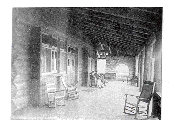
After taking a carriage drive or a walk along the canyon rim
guests could relax in rocking chairs that were placed on the wide porch.
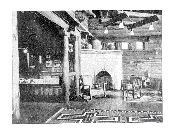
On cooler days pine or juniper logs added warmth to the spacious lobby
decorated with Indian Pottery old firearms and stuffed animal heads.
Indian rugs added a touch of color to the polished wood floors.
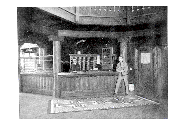
Guests were always welcomed at the reception desk in the rotunda
just beyond the lobby. Fred Harvey, the concessionaire, hired
Hopi Indian men as bellhops to offer assistance.
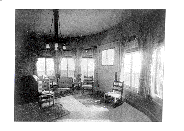
The second floor mezzanine offered the ladies a place to relax and read or sew.
Many long friendships were made here.
Occasionally someone would doze off to dream of the wonders of the Canyon.
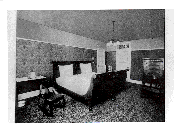
An elegant two room suite was provided a comfortable bed and ample storage
space. Just beyond was a private bath and living room area.
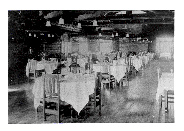
Fred Harvey Girls added the customary touch to dining where the men
were required to wear jackets and women dressed in their finest.
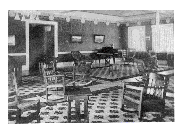
The music room was a favorite place to gather in the evenings.
Fred Harvey provided speakers, plays and music entertainment.
In later years movies were shown on Sunday nights.
Things have changed at El Tovar, but even today she holds her head high above the throngs of tourists that crowd into her lobby and dinning room as if to say, "I'm still the queen of the Grand Canyon rim".
******
Used by permission of the Grand Canyon Pioneers Society.
|
|
|---|
|
|---|